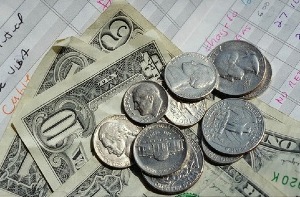 Not getting paid by clients or customers is one of the most frustrating aspects of running a small business. But when not getting paid impacts your small business’s cash flow, it’s one of the most dangerous, too. What small business owner hasn’t worried about getting paid at some point? Whether it’s the number of customers that are running past due accounts, or the client who seems to be reluctant to pay for completed work, having proactive policies in place that anticipate these eventualities is your best defense.
Not getting paid by clients or customers is one of the most frustrating aspects of running a small business. But when not getting paid impacts your small business’s cash flow, it’s one of the most dangerous, too. What small business owner hasn’t worried about getting paid at some point? Whether it’s the number of customers that are running past due accounts, or the client who seems to be reluctant to pay for completed work, having proactive policies in place that anticipate these eventualities is your best defense.
Here are seven ways to make sure you get paid for the goods and services you sell.
1. Don’t extend credit automatically to new customers/clients.
Small businesses, just like large businesses, need to have credit policies in place that provide guidelines for determining which customers or clients will be extended credit and on what terms.
It may be your business’s policy, for instance, to never accept personal checks as payment, only company checks, debit cards, credit cards or cash.
If you are considering extending credit beyond that point to individual clients or customers, you should have a procedure set up where the customer or client has to fill out a credit application and/or do a customer credit check. The fee for a credit report can seem expensive depending upon how detailed the report is, but it’s definitely money well spent if it prevents you from not getting paid for that big sale.
2. Take partial payment in advance.
If it’s sensible in terms of the price of the goods or services, ask for a deposit or retainer up front. This is an increasingly common business practice for higher-ticket items and services; no reasonable customer should be offended by such a request.
For instance, if you provide services, you might charge a percentage of the projected bill or a set amount as a retainer before you start work on a project with the remainder due on completion of the task. Or break the bill into thirds, asking for a third before work starts, a third halfway through the project and a third upon completion.
The beauty of partial payment is that it ensures that you get paid something even if the customer or client defaults on the rest of the bill.
3. Invoice promptly.
This seems like a no-brainer but many businesses are slow to invoice their clients. And by establishing the degree of urgency with their own example, why should anyone be in any hurry to pay them?
Customer/client invoices should be prepared and presented immediately upon delivery of the goods or services, or as soon as reasonably possible. Not doing so can make your business look indifferent to getting paid and slow down your cash flow for no reason. Waiting to prepare your invoices at the end of the month, for example, you may be adding as many as thirty extra days to your cash flow conversion period. QuickBooks software and Point of Sale systems make quick invoicing easy.
4. State payment terms visibly and clearly.
If you want to get paid promptly, don’t leave it up to the customer or client to decide when your invoice should be paid. Rather than giving them invoices that say vague things such as “Payable upon receipt”, make sure your invoices state specific payment terms, such as “Payable within 30 days” or “Due Date: ____________”. Your invoices should encourage prompt action on the part of your customer.
5. Reward customers for paying promptly.
Offering customers a discount for paying their invoices early, can help you get paid more quickly. For instance, if the usual policy is to have payments due in 30 days, offer a small discount such as two percent to customers who pay within 10 days.
6. Establish a follow up procedure for customers who miss payments.
Even if you’ve never had a collection problem to date, you should still have a system in place for flagging late payments, and a procedure for contacting the customer or client when the payment is late. The more quickly you follow up on a missed payment, the better your chance of getting paid.
Typically, such a procedure starts with a letter that simply states the bill is overdue and requesting the customer’s immediate attention to the matter. Nowadays there are many channels that you can use to contact the customer. Some are more effective than others. If time allows, I recommend starting out with a phone call to “touch base” with the customer or client. You want to come across as friendly and polite, not threatening in any way. Sometimes the person has just forgotten or missed seeing a bill and a quick phone call is all it takes, meaning you get paid and you don’t have to go through any of the rest of the collections procedure.
Sending collection letters via email is nice because it automatically creates a copy of the collection letter for your files, and automatically date stamps your message. However, because of email filtering and email overload, it may not be a very effective way of getting your collection letters to customers and clients. You’ll want to send them in other ways, too, such as regular mail, fax or even courier, depending upon the size and importance of the debt.
7. Turn the overdue account over to a collection agency.
Collection agencies collect debts for a fee or percentage of the total amount owed. This fee is based on how old the debts are (the fresher the better) and how much business a creditor has to offer. Expect the rate for collecting consumer accounts to be higher than for business-to-business accounts. Collection agencies have experience with, and knowledge about debt collection that you, as an individual business owner, don’t have and hiring one can be well worth it, if the amount of outstanding accounts receivable warrants it.
Proactive Policies Are the Best Way to Get Paid
As you can see, the best ways to ensure you get paid for the products you sell and the services you provide is to have proactive policies and procedures in place to cut down on the number of delinquent accounts receivable your small business has to deal with.
Things such as having credit policies in place, performing credit checks, having a partial payment policy and being clear and upfront about your payment expectations, both in person and on your invoices will go a long ways towards ensuring that you get paid, and your small business doesn’t get stuck with a lot of bad debt.



